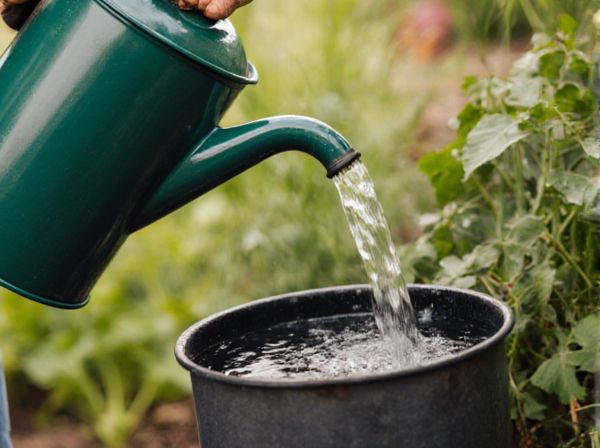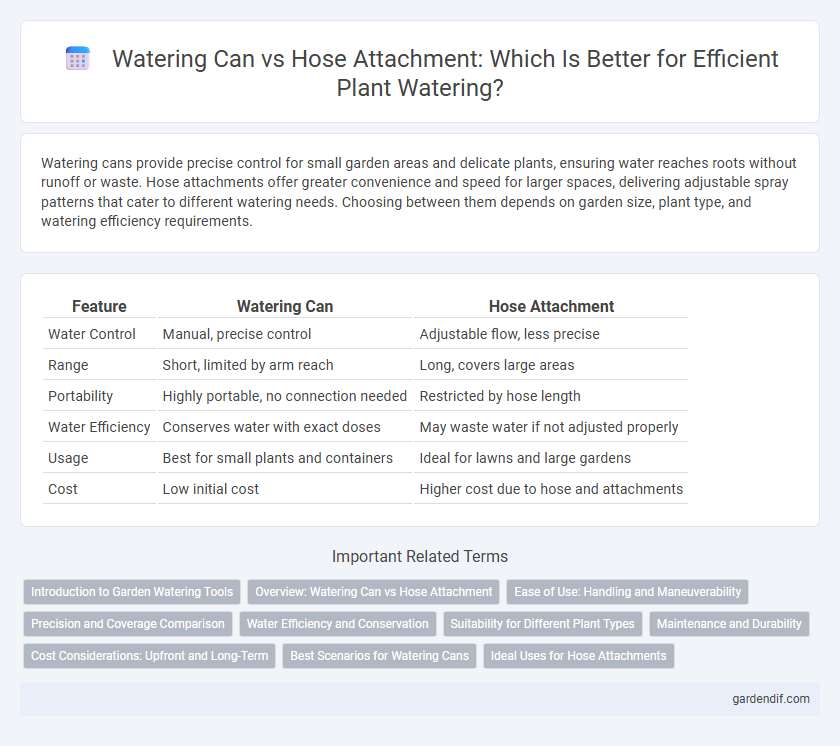
Watering can vs Hose attachment Illustration
Watering cans provide precise control for small garden areas and delicate plants, ensuring water reaches roots without runoff or waste. Hose attachments offer greater convenience and speed for larger spaces, delivering adjustable spray patterns that cater to different watering needs. Choosing between them depends on garden size, plant type, and watering efficiency requirements.
Table of Comparison
| Feature | Watering Can | Hose Attachment |
|---|---|---|
| Water Control | Manual, precise control | Adjustable flow, less precise |
| Range | Short, limited by arm reach | Long, covers large areas |
| Portability | Highly portable, no connection needed | Restricted by hose length |
| Water Efficiency | Conserves water with exact doses | May waste water if not adjusted properly |
| Usage | Best for small plants and containers | Ideal for lawns and large gardens |
| Cost | Low initial cost | Higher cost due to hose and attachments |
Introduction to Garden Watering Tools
Watering cans offer precise control for small-scale watering tasks, making them ideal for potted plants and delicate seedlings. Hose attachments, such as spray nozzles and timers, provide efficient water delivery for larger garden areas, reducing manual effort and conserving water. Selecting the right garden watering tool depends on plant types, garden size, and watering frequency.
Overview: Watering Can vs Hose Attachment
Watering cans provide precise control and are ideal for small gardens, container plants, and delicate seedlings. Hose attachments offer convenience and speed, suitable for larger areas and heavy watering needs. Choice depends on garden size, plant type, and water pressure availability.
Ease of Use: Handling and Maneuverability
A watering can offers precise control and easy handling, making it ideal for small gardens and potted plants without the need for a water source nearby. Hose attachments provide greater reach and continuous water flow, but can be heavier and less maneuverable, especially in tight spaces. Choosing between the two depends on the garden size and the user's physical comfort during watering tasks.
Precision and Coverage Comparison
Watering cans provide precise control for targeted watering of small plants or seedlings, allowing gardeners to avoid overwatering and soil erosion. Hose attachments cover larger areas efficiently, offering adjustable spray patterns that make them suitable for watering lawns and garden beds quickly. While watering cans excel in accuracy, hose attachments deliver superior coverage and time-saving benefits for extensive watering tasks.
Water Efficiency and Conservation
Watering cans offer precise control, minimizing water waste by targeting plant roots directly, which enhances water efficiency in small garden areas. Hose attachments with shut-off valves and adjustable nozzles facilitate conservation by regulating flow rate and reducing runoff during larger scale watering. Choosing the right watering tool depends on garden size and plant type to optimize water use and promote sustainable gardening practices.
Suitability for Different Plant Types
Watering cans offer precise control, making them ideal for delicate seedlings and indoor plants that require gentle hydration. Hose attachments provide a more efficient water flow, suitable for larger garden beds and drought-resistant plants needing thorough soaking. Selecting the appropriate watering tool ensures optimal moisture delivery tailored to specific plant types and their growth stages.
Maintenance and Durability
Watering cans require minimal maintenance, primarily involving regular cleaning to prevent clogging and corrosion, ensuring long-lasting use. Hose attachments, while also durable, often demand more frequent checks for leaks, gasket wear, and hose compatibility to maintain optimal functionality. Both options benefit from proper storage, but watering cans generally exhibit greater longevity under low-maintenance conditions.
Cost Considerations: Upfront and Long-Term
Watering cans typically require a lower upfront investment, often costing between $10 and $30, making them an economical choice for small gardens or container plants. Hose attachments may have higher initial costs, ranging from $20 to $100 depending on features like adjustable spray patterns, but they offer long-term savings by reducing water waste and time spent watering. Over time, the efficiency and durability of hose attachments can offset their initial expense, especially for larger gardens with frequent watering needs.
Best Scenarios for Watering Cans
Watering cans are ideal for precise watering in small gardens, indoor plants, and seedlings where controlled flow minimizes overwatering and soil erosion. Their portability and spout design allow targeted application in tight spaces or container plants that hoses may oversaturate. Watering cans excel in delicate environments where gentle, consistent moisture is crucial for plant health.
Ideal Uses for Hose Attachments
Hose attachments are ideal for covering large garden areas efficiently, providing consistent water pressure and customizable spray patterns for various plant types. They reduce water waste by targeting specific zones and are perfect for washing outdoor surfaces, watering lawns, and filling large containers quickly. Unlike watering cans, hose attachments save time and effort in extensive watering tasks, especially in bigger gardens or during dry seasons.
Watering can vs Hose attachment Infographic

 gardendif.com
gardendif.com